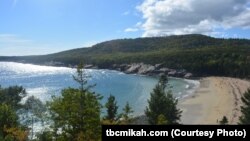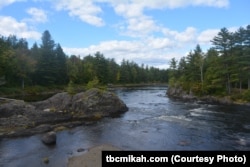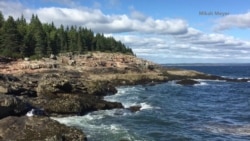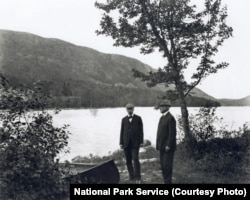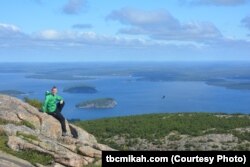There are more than 400 sites in the U.S. National Park Service, and Mikah Meyer plans to visit all of them. Most recently, he's been in the northeastern state of Maine, where he’s noticed a recurring theme ... that many of the vast and beautiful natural areas open to visitors like him would probably not have remained so had it not been for the generosity of a dedicated group of wealthy Americans.
Patriotic philanthropy
A good example of that philanthropy was a park Meyer had recently visited: the Katahdin Woods and Waters National Monument, which President Barack Obama just designated as a national park.
The land, which encompasses about 35,000 hectares (87,500 acres) of spectacular woods and waterways, was purchased and donated to the National Park Service by Roxanne Quimby, a Maine resident and devoted conservationist who founded the hugely successful company Burt's Bees. The company makes natural, Earth-friendly personal care products.
The entrepreneur, environmentalist and philanthropist donated the land, “and also a $40 million endowment to help improve the park and pay for the services,” Meyer said.
A family affair
Quimby formed the Quimby Family Foundation in 2004 with the vision “to advance wilderness values and to increase access to the arts throughout Maine.”
Meyer had a chance to meet with Quimby’s son, Lucas St. Clair, an avid outdoorsman and conservationist whose childhood years in Maine fostered his deep love and respect for the outdoors.
St. Clair, who is a member of the foundation's board of directors, spoke with Meyer about the challenges of creating a national monument.
“We talked for over an hour about the almost decade-long process of getting Katahdin to become a national park site and how much work, time, energy and money has gone into doing this,” Meyer said. “It made me think about the time and effort it must have taken to create all the other 412 sites within the National Park Service. And I’m guessing that all of them probably took as much, or similar amount of work.”
Acadia – celebrating 100 glorious years
Meyer is right.
Purchasing land and donating it to the park service has been an enduring tradition in the U.S. — particularly in this part of the country. And it takes a huge amount of work.
Acadia National Park is another example of a spectacular land and waterscape that’s been preserved and protected thanks to the generosity of dedicated, conservation-minded Americans over several generations.
The very first national park established east of the Mississippi River, Acadia is over 20,000 hectares (50,000-acres) of lush woodland, rocky beaches, historic carriage roads and majestic granite mountains.
Its highest peak, Cadillac Mountain, at 466 meters (1,530 feet) is the highest point along the eastern coast and a place where visitors can be the first to see the sunrise in the United States from early October through early March. Its pristine lakes and ocean coastlines are home to a variety of plants and wildlife including moose, bear, whales and seabirds.
“What I think made Acadia unique was that you have these big mountains right next to the ocean … so that juxtaposition of the rocks and the waves and the mountains seem to be Acadia’s signature,” Meyer observed.
Roxanne Quimby — who donated the Katahdin land — also recently purchased some land near Acadia, Meyer said, “donating about 32 hectares [80 acres] to the Acadia Park to preserve it for future generations.”
“It was just fascinating to learn how as a family, they were able to use their particular strengths to acquire the land and then go through the whole process of convincing the public that this is something that is worth going through with,” Meyer said. “I just really admire all of the work that these people put into something that they didn't have to do.”
But before the Quimby family, there were others.
Early beginnings
Many attribute Acadia's enduring existence to the early efforts of American academic Charles W. Eliot, Harvard University's longest-serving president (1869-1909), who helped shape the university into a highly esteemed, world-renowned institution.
Eliot formed the Hancock County Trustees of Public Reservations in 1901, with the mission of “... acquiring, owning and holding lands and other property in Hancock County for free public use.” Essentially, to protect the natural resources of Maine’s Mount Desert Island, where his son — a landscape architect who died at 38 — vacationed, and had hoped to expand public access.
The father of Acadia National Park
George B. Dorr — who studied at Harvard — became known as a gentleman scholar and conservationist. He co-founded the trustees organization and spent most his adult life working in support of the establishment, care and expansion of the park, devoting not only his time but much of his personal wealth. As a result of his efforts, he became known as the "father of Acadia National Park."
The peoples’ playground
Another wealthy recruit to the effort was John D. Rockefeller, Jr., a member of one of the most powerful families in America — known for its long tradition of supporting national parks by establishing or enhancing more than 20 of them, from Maine to Wyoming.
Rockefeller also had a vacation cottage on Mount Desert Island. He donated about 4,047 hectares (10,000 acres) to Acadia and financed and directed the construction of the historic carriage roads, the Park Loop Road, the gatehouses and a number of other iconic buildings.
“Acadia was fascinating in that it was once this playground to the wealthy,” Meyer noted, “Charles W. Eliott — then-president of Harvard — used to bring his boat up to the area and it was he and Dorr who really spearheaded the start of Acadia.”
“It’s interesting to see how what was once private wealthy people's playgrounds is now a public playground,” he added.
And as Acadia National Park rightly references in its online sites, there were countless other individuals who contributed to its creation by giving through their labor, or “generously gave properties they had purchased or inherited so they might be protected and enjoyed by all for generations to come.”
Enduring gestures
Meyer feels lucky to be one of the many millions of visitors who enjoy America’s national parks every year and to be able to benefit from the generosity of conservationists who had the foresight to protect lands he feels sure would have fallen victim to privatization or development.
“This whole time to New England — from Vermont, New Hampshire and now to Maine — a large theme has been wealthy American philanthropists who donate natural lands so that the rest of America can experience what they were fortunate enough to experience,” Meyer concluded.
Through the collaborative efforts of these conservation-minded citizens, the creation and preservation of America’s first eastern national park is just one example of an enduring tradition established by President Woodrow Wilson 100 years ago ...
“To conserve the scenery and the natural and historic objects and the wildlife therein and to provide for the enjoyment of the same in such manner and by such means as will leave them unimpaired for the enjoyment of future generations."
Follow Mikah
To follow Mikah and learn more about the places he’s traveling to, he invites you to visit him on his website.




